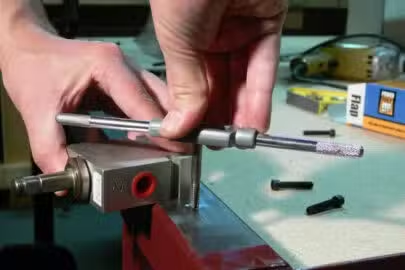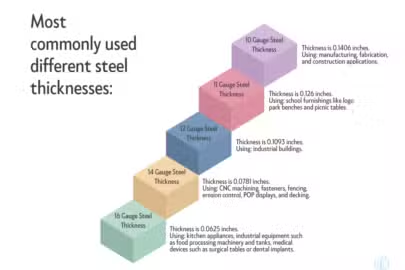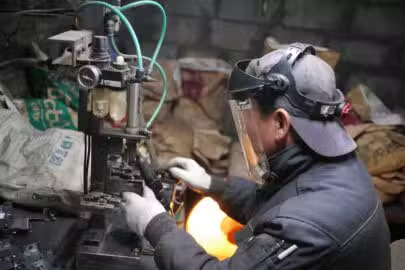Sheet metal is the foundation of modern engineering. It can be found everywhere, from cars and machines to house facades and furnishings. This has resulted in a wide range of sheet metal material options on the market. So, it is essential to choose the right one for your project. The component of the design, manufacturing process, cost, and performance will all be influenced by the sheet metal type chosen during the product design process.
Sheet metal refers to metal that has been formed into thin, flat pieces, typically varying in thickness from about 0.02 inches to 0.25 inches. It is one of the fundamental forms used in production and can be made from a variety of metals, including steel, aluminum, brass, copper, and more.
Engineers must have a fundamental understanding before starting any project to make the most of sheet metal. This covers common measurements, components, variations in production, and forming methods. Let’s look closer at common sheet metals with their pros, cons, and applications.
Different Types of Sheet Metal Materials

Here are the common types of sheet metal materials used in production and rapid metal prototyping:
Stainless Steel
Stainless steel is arguably the best sheet metal material. It combines durability and attractiveness to rank among the best on the market. 13%by by Chromium, Nickel, and Molybdenum are present in stainless steel.
It is available in several varieties, including austenitic steel sheets, martensitic steel, and sheets of ferritic steel. Each type has specific properties that make it suitable for different applications.
Pros
- Corrosion Resistance: Stainless steel has an excellent corrosion resistance, making it suitable for applications in harsh environments.
- Strength: It has high tensile strength, making it a durable material for various applications.
- Aesthetic Appeal: Steel sheet metal has a sleek and modern appearance, making it popular in applications where aesthetics matter.
- Hygienic Properties: It is easy to clean and maintain, making it suitable for applications in the food and medical industries.
Cons
- Cost: Stainless steel is quite expensive than other sheet metal materials.
- Hardness: While generally durable, certain types of stainless steel may not be as hard as other materials.
Applications
- Kitchen Appliances: Stainless steel is commonly used for making kitchen sinks, countertops, and appliances.
- Medical Equipment: Due to its hygienic properties, it is used to produce medical instruments and equipment.
- Architectural Elements: Stainless steel is often used in architectural applications such as facades, railings, and decorative elements.
Alloy Steel
Alloy steel incorporates other elements, such as manganese, silicon, nickel, titanium, copper, chromium, and aluminum, to enhance its properties. The addition of these elements imparts specific characteristics to the alloy steel. Alloy steel comes in various grades with different alloying elements.
The choice of alloying elements depends on the desired properties for a particular application, such as increased strength, hardness, or resistance to wear.
Pros
- Strength and Toughness: Alloy steel is known for its high strength and toughness, making it suitable for demanding applications.
- Versatility: Alloy steel can be tailored for specific applications by adjusting its composition.
- Heat Resistance: Some alloy steels exhibit good heat resistance, making them suitable for high-temperature applications.
Cons
- Corrosion Resistance: While alloy steel is generally corrosion-resistant, it may not offer the same level of corrosion resistance as stainless steel.
- Cost: Alloy steel can be more expensive than basic carbon steel.
Applications
- Automotive Industry: Alloy steel is often used to manufacture car parts, such as gears, axles, and engine components.
- Aerospace: Due to its durability and strength, alloy steel is used in the aerospace industry for components like landing gear and structural elements.
- Oil and Gas Industry: Alloy steel is utilized in producing pipelines and equipment for the oil and gas sector due to its strength and corrosion resistance.
Carbon Steel
Iron alloyed with carbon gives this precision sheet metal substance a high level of durability. A manufacturer can choose steel with low, medium, or high carbon content levels based on the specific requirement.
Low carbon levels produce a highly adaptable material commonly used in everyday items such as fences and gates. Medium carbon steel is widely used in appliances and automobiles. A higher carbon content results in a more fragile component, ideal for delicate items such as cables.
Pros
- Cost-Effective: Carbon steel is generally more affordable than other types of steel.
- High Strength: It offers high tensile strength, making it suitable for various structural applications.
- Weldability: Carbon steel is easily weldable, allowing for easy fabrication.
Cons
- Corrosion Susceptibility: Carbon steel is susceptible to corrosion, especially in humid or corrosive environments.
- Less Ductility: It may have lower ductility than other steel types.
Applications
- Construction: Carbon steel is widely used for structural components like beams, columns, and reinforcement bars.
- Pipelines: It is used to produce pipelines for transporting liquids and gases.
- Automotive: Carbon steel is employed in manufacturing automobile parts and chassis components.
Galvanized Steel

Two prevalent forms of galvanized steel used in construction are electro-galvanized sheets and hot-dipped metallic-coated sheets. Electro-galvanized sheets are produced from cold-rolled and annealed steel, coated entirely in zinc without the presence of a zinc spangle.
In contrast, hot-dipped metallic-coated sheets contain cold-rolled robust steel plates with an iron-zinc alloy and pure zinc coating. This type of galvanized steel is relatively more cost-effective and offers superior corrosion resistance compared to electro-galvanized sheets.
Pros
- Corrosion Resistance: The zinc coating protects the underlying steel from corrosion.
- Longevity: Galvanized steel has a longer lifespan compared to untreated carbon steel.
- Versatility: It can be used in various applications due to its corrosion resistance.
Cons
- Initial Cost: Galvanized steel can be more expensive upfront due to the galvanization process.
- Aesthetics: The appearance may not be as sleek as stainless steel.
Applications
- Outdoor Structures: Galvanized steel is commonly used for fencing, outdoor furniture, and roofing.
- Automotive Panels: It is used for automotive panels and body parts.
- Water Pipes: Galvanized pipes are used for water distribution in some applications.
Tool Steel
Tool steel, an exceptionally versatile alloy with 1% carbon, is renowned for its strength. Similar to alloy steel, it incorporates various elements in different proportions based on its intended application.
This diversity in composition grants tool steel resistance to abrasion and effective performance in extreme temperatures. Its unique characteristics make it an ideal material for crafting tools such as hammers, punches, dies, and blades.
Pros
- Hardness: Tool steel exhibits high hardness, making it suitable for cutting and shaping tools.
- Wear Resistance: It has excellent wear resistance, ensuring durability in tool applications.
- Heat Resistance: Tool steel can withstand high temperatures without losing its hardness.
Cons
- Brittleness: In some applications, tool steel can be more brittle than other steel types.
- Cost: It can be more expensive than general-purpose carbon steel.
Applications
- Cutting Tools: Tool steel is widely used for making cutting tools such as drills, saws, and machining tools.
- Dies and Molds: It is used for dies and molds in manufacturing processes.
- Precision Parts: Tool steel is employed for precision parts with critical hardness and wear resistance.
Cold Rolled Steel
This is a type of steel that has been processed at room temperature to achieve desired properties. It has a smoother surface finish than hot rolled steel. Cold rolled stone is available in 1008 and 1018 alloys.
Pros
- Surface Finish: Cold rolled steel has a smoother and more polished surface than hot-rolled steel.
- Tight Tolerances: Cold rolling allows for more precise dimensions and tighter tolerances.
- Strength: It has improved stability compared to hot-rolled steel in some applications.
Cons
- Limited Shape Complexity: Cold rolling may limit the complexity of shapes compared to hot rolling.
- Higher Cost: Cold rolled steel is generally more expensive due to the additional processing.
Applications
- Automotive Components: Cold rolled steel is used for automotive parts like body panels and frames.
- Appliances: It is common in manufacturing appliances like refrigerators and washing machines.
- Construction: Cold rolled steel finds applications in construction for roofing, siding, and structural components.
Aluminum
Aluminum stands out as a preferred option for cases requiring a lightweight material. It exhibits remarkable corrosion resistance even in its unfinished state. Besides its durability, aluminum is well-suited for laser cutting, welding, and machining.
Pros
- Lightweight: Aluminum is lightweight, making it ideal for applications where weight is essential, such as in the aerospace and automotive industries.
- Corrosion Resistance: Aluminum sheet metal naturally forms a protective oxide layer, providing excellent corrosion resistance.
- Conductivity: It has good electrical and thermal conductivity, making it suitable for electrical wiring and heat exchange applications.
- Recyclability: Aluminum is highly recyclable, contributing to sustainability efforts in various industries.
Cons
- Softness: Aluminum is relatively soft compared to some other metals, which can affect its wear resistance in specific applications.
- Higher Cost: In some cases, aluminum can be more expensive than other materials.
Applications
- Aerospace: Aluminum is widely used in the aerospace industry for aircraft components due to its lightweight and corrosion-resistant properties.
- Automotive: It is used for various automotive parts, including body panels, wheels, and engine components.
- Construction: Aluminum is used to construct windows, doors, and structural components.
- Packaging: Aluminum is commonly used in packaging materials, cans, and foils.
Copper
Copper, a versatile metal with exceptional conductivity and corrosion resistance, is significant in various industries. Its excellence in electrical applications and natural antimicrobial properties make it worthwhile in electrical wiring, electronic components, and even specific medical settings.
Pros
- Excellent Conductivity: Copper is an good conductor of electricity, making it vital for electrical wiring and electronic components.
- Ductility: Copper is highly malleable, allowing it to be quickly drawn into thin wires for electrical applications.
- Corrosion Resistance: Copper has good corrosion resistance, especially in atmospheric conditions.
- Antimicrobial Properties: Copper’s natural antimicrobial properties make it suitable for specific medical and touch surface applications.
Cons
- Cost: Copper can be more expensive than some other metals.
- Weight: Copper is denser than aluminum, making it heavier in specific applications.
Applications
- Electrical Wiring: Copper is commonly used in electrical wiring and conductors due to its excellent conductivity.
- Plumbing: Copper pipes are commonly used in plumbing systems because of their corrosion resistance.
- Electronics: Copper is used to manufacture various electronic components and printed circuit boards.
- Roofing: Copper roofing is known for its durability and aesthetic appeal, especially in architectural applications.
Applications of Sheet Metal Parts

Here are some of the applications of sheet metal parts produced through the sheet metal fabrication process:
Automobile Parts
Sheet metal is extensively used in the automotive industry for manufacturing various components. This includes body panels, fenders, hoods, doors, and structural parts. The formability of sheet metal allows for creation of complex shapes and contours needed in modern vehicle design.
Electrical and Electronics
Sheet metal is utilized in the manufacturing of electrical and electronic components. This includes panels, enclosures, chassis, brackets for electronic devices, control panels, and communication equipment. The metal’s properties, such as conductivity and shielding capabilities, make it suitable for these applications.
Chassis Construction
In the construction of vehicles and machinery, sheet metal plays a crucial role in creating chassis components. This includes frame rails, brackets, and support structures. The strength and formability of sheet metal contribute to the structural integrity of the chassis.
Custom Brackets and Small Components
Sheet metal is ideal for creating custom brackets and small components in various industries. These can range from simple frames used in furniture assembly to intricate custom components in machinery and equipment. The ability to cut, bend, and shape sheet metal allows for fabricating precise and tailored solutions.
Enclosures and Housings
Sheet metal is commonly employed in constructing enclosures and housings for various applications. This includes electrical enclosures, control cabinets, and protective housings for machinery. The durability and customizable nature of sheet metal makes it suitable for protection and containment.
How to Choose the Best Sheet Metal Material for Your Project

Before selecting any sheet metal for your project, there are some things you need to consider. Here are the things to consider:
Yield Strength
This is the measure of stress a material can withstand without permanent deformation or a noticeable change in shape. Choose a sheet metal material with an appropriate yield strength for your project. Higher yield strength is often preferred for structural components requiring load stability.
Hardness
Hardness measures a material’s resistance to deformation, indentation, or scratching. The required hardness depends on the application. A more rigid material may be necessary for cutting tools and abrasive environments. For applications where forming or bending is critical, a material with moderate hardness and good flexibility may be preferable.
Tensile Strength
This is the maximum amount of tensile (pulling) stress a material can withstand without breaking. Consider the tensile strength needed for your project. High tensile strength is crucial for load-bearing components, while lower tensile strength may be acceptable for parts subjected to less stress.
Machinability
Machinability determines how easily a material can be machined or worked using various tools and processes. Consider the material’s machinability if your project involves extensive machining, forming, or welding. Some materials may be more challenging to work with but offer superior properties, while others may be more easily machined but have limitations regarding strength or other characteristics.
Ductility/Formability
Ductility and formability refer to a material’s ability to undergo deformation without breaking. This is crucial for bending, shaping, or forming sheet metal applications. For projects requiring complex shapes or intricate designs, materials with high flexibility, such as aluminum and certain types of steel, are favorable.
Weldability
Weldability varies according to metal. Some are faster to wield than others. Thus, purchasing a metal that can be easily wielded and does not necessitate additional time and expertise is critical, which will increase the budget and timing.
Corrosion Resistance
Corrosion resistance is crucial for projects exposed to environmental factors, chemicals, or moisture. Stainless steel and aluminum are known for their excellent corrosion resistance. Galvanized steel, with a zinc coating, also provides adequate protection against corrosion.
Weight
Weight considerations are crucial, especially in applications directly impacting performance, transportation costs, or structural integrity. Aluminum is lightweight, making it ideal for applications where weight reduction is essential. In contrast, steel is heavier but offers other advantages in terms of strength.
Cost
Cost is a significant factor in material selection and can impact the overall project budget. Materials like carbon steel are often more cost-effective, making them suitable for projects with budget constraints. However, weighing the cost against other factors like durability and performance is essential.
Zintilon Reliable Sheet Metal Fabrication Services
When it comes to sheet metal fabrication services, Zintilon is your reliable choice for precision and quality. Why opt for Zintilon? We are experts in the field, turning your ideas into perfectly crafted metal products.
Zintilon stands out for its skilled team and cutting-edge technology. Every project, big or small, gets the attention it deserves. Need something custom? We’ve got you covered, delivering solutions tailored to your unique needs.
Our team uses the latest tech to ensure your metal components meet the highest standards. Plus, we’re forward-thinking, embracing eco-friendly practices. Zintilon has a proven track record of reliability in the world of sheet metal fabrication. Countless satisfied clients testify to our ability to exceed expectations. Zintilon is the partner you can trust for your projects, large or small. Get a quote today!




